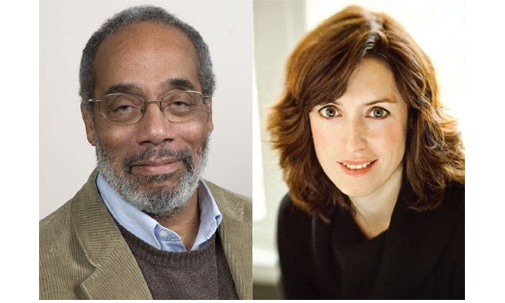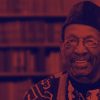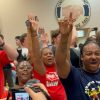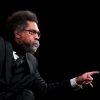
Cobb, author of This Nonviolent Stuff’ll Get You Killed: How Guns Made the Civil Rights Movement Possible, and Danielle McGuire, a historian at Wayne State University, discuss the fundamental role of armed resistance in the civil rights movement.
On his first visit to Martin Luther King Jr.’s house in Montgomery, Alabama, the journalist William Worthy began to sink into an armchair. He snapped up again when nonviolent activist Bayard Rustin yelled, “Bill, wait, wait! Couple of guns on that chair!” Worthy looked behind him and saw two loaded pistols nestled on the cushion. “Just for self-defense,” King said.
In his new book, This Nonviolent Stuff’ll Get You Killed: How Guns Made the Civil Rights Movement Possible, Charles E. Cobb, a former field secretary for the Student Nonviolent Coordinating Committee and a visiting professor of Africana Studies at Brown University, explores what he sees as one of the movement’s forgotten contradictions: Guns made it possible. According to Cobb, civil-rights leaders recognized that armed resistance was sometimes necessary to preserve their peaceful mission. Guns kept people like King alive.
Danielle L. McGuire, an assistant professor of history at Wayne State University, argues that armed self-defense was also far more common for black women in the South than has generally been acknowledged. In her 2010 book, At the Dark End of the Street: Black Women, Rape, and Resistance, McGuire contends that the decision by women to combat sexual abuse and violence—sometimes with force—was one of the sparks that led to the modern civil-rights movement.
On the 50th anniversary of Freedom Summer, McGuire and Cobb discuss the legacies of nonviolent resistance and community organizing—and how hidden histories complicate familiar narratives about the civil-rights movement.
————————————————————————————————————
Danielle McGuire: It seems clear that only love could have animated the civil-rights movement. Individuals’ willingness to give themselves completely over to a cause, for local people to open their homes and put themselves and their families at risk, to stay up all night guarding the homes so activists could sleep, to feed and house people they may have just met—is this what activists in the civil-rights movement meant when they talked about the beloved community?
Charles Cobb: When you look at the organizing tradition of the Southern civil-rights movement, what you see is love and commitment. They function on several different but related levels. First, we young people had to make a commitment. A lot of us left school to work in the Deep South, which was a violent and dangerous place—we had to be committed to struggle and committed to each other. So that’s a kind of community. But then there were the people we were working with, too—the community we were embedded in. They embraced us as allies for change, but they also loved us, like we were in their family. They were willing to protect us just the way they’d protect any of their children, with guns if necessary. Hartman Turnbow, a small farmer and activist in Mississippi, once said, “I had a wife and I had a daughter and I loved my wife just like the white man loved his’n and a white man will die for his’n and I say I’ll die for mine.” I think they thought of us, and were committed to us, in much the same way.
I was in Birmingham a few years ago, speaking with some civil-rights-movement veterans there. One of them told me that whenever Martin Luther King Jr. was in town, he helped to protect him. That’s all he said, so I asked, “How did you protect him?” And he said, “With a nonviolent .38 police special.” Everyone laughed and nodded these knowing smiles.
Protection was common, even if it wasn’t publicly acknowledged. You couldn’t live in any household in a rural Southern community without guns, and people weren’t afraid to use them. During the Montgomery, Alabama, bus boycott, Reverend King had guns all over his house. Glenn Smiley, one of King’s advisers, called King’s home an “arsenal.” That’s a Southern thing. I’ve been in houses where guns have been in the nightstand, under the pillow, in the chair.
One of the images in your book was especially powerful. It was a photo of men sitting up guarding one of the Freedom Schools, which were designed to promote adult literacy and combat the poor education that could be found in public schools. Those schools gave students the space to think about how they could transform their community. In the picture, the men were protecting the space where that transformation could take place.
One of the arguments I make in the book is that World War II was a crucial turning point. Black soldiers were coming home, after fighting Nazis or Japanese fascists or Italian fascists, to the South, and they started to register to vote and join the NAACP. I don’t think their leadership can be entirely ascribed to their experience with combat, but it was a tipping point. They were used to fighting, and they weren’t inclined to just go back to the old white-supremacist order.
They weren’t coming home to pick cotton.
No, they weren’t. That’s why when defiance started to emerge in the postwar period, activists who considered themselves part of a nonviolent movement were very committed to armed self-defense. There was a group called Deacons for Defense and Justice in Louisiana that was dedicated to the idea of protecting nonviolent organizers but was formed around the notion of armed resistance to white supremacist terrorism. There was an unnamed group in Tuscaloosa, Alabama, that protected Martin Luther King’s Southern Christian Leadership Conference chapter with guns. They were all ex-soldiers.
I studied a series of rape cases, which were another catalyst for black women—and also black men—to get involved in their community. One of the first cases Rosa Parks worked on when she joined the NAACP in the 1940s was the case of Recy Taylor, a sharecropper in Abbeville, Alabama, who was walking home from a church revival one night when she was held up at gunpoint and kidnapped by a group of white men. They took her outside town and brutally assaulted her. She somehow found the strength and physical capability to come back into town after they abandoned her, and she told the sheriff what happened. Word filtered back to the Montgomery NAACP, and Rosa Parks came to investigate. She and other militant activists turned Recy Taylor’s case into a nationwide movement. It was all over black newspapers. People were organizing up in Harlem; labor unions were raising money for a case to bring her assailants to justice. The governor of Alabama was so nervous he ordered a private investigation to look into the case. It’s all part of this tradition of black women organizing to protect themselves from attack and passing down lessons to their daughters, nieces, sisters about how to protect themselves when they’re out alone, if they’re walking home, if they’re working in a white home.
The Montgomery bus boycott was sparked by the action of one woman, Jo Ann Robinson. She was an English professor at Alabama State, a historically black college, and when she heard that Rosa Parks had been arrested, she gathered some of her students and mimeographed the leaflets that night, calling for a bus boycott. The preachers who get credit for organizing it were actually hemming and hawing and probably wouldn’t have come around to a boycott if Robinson hadn’t pushed for it. Many of the women who led the Montgomery bus boycott had been involved with the Recy Taylor case, actively seeking justice for her.
The women who rode the buses weren’t just upset that they had to pay in the front and enter in the rear, or sit in the back. They were resisting a culture of widespread violence against black women. Bus drivers had police power, they kept pistols under their seats, and they could abuse black women with no consequences. One woman said the bus drivers “liked to talk under folks’ clothes.” Because black women made up the majority of the city ridership, they were the ones who were bearing the brunt of the violence on the buses. And then, of course, they were taking the buses to go to work mostly in white women’s kitchens where they were also susceptible to attack.
But they had this tremendous economic power because if women refused to ride, the buses wouldn’t make money. It wasn’t the guys riding the bus. It was the maids and the cooks and the baby-sitters and housecleaners, who were overwhelmingly women. And when you look at the organization of the bus boycott, they really were the driving force.
Which is pretty amazing, because black women were so vulnerable in the South. White men, especially police officers and cab drivers, could pick them up and assault them with impunity.
But at the same time, there was also a culture and a history of immense strength, going back before the modern civil-rights movement of the 1950s and 1960s even began. There’s the story of Annie “Mama Dolly” Raines, in southwest Georgia, up in the window with her shotgun protecting Charles Sherrod, the nonviolent organizer who was staying with her. She was a midwife and she told him, “I brought a lot of these white folks into this world, and I’ll take ’em out of this world if I have to.” That’s what people overlook in discussions of this period. Yes, there was tremendous oppression, brutal oppression. But there was also strength, which is part of what oppression generates. There were good grounds for fear, but that fear created a kind of toughness that wasn’t limited to the men. I can certainly testify that without the women, I might be dead.
One of the most profound stories from the Mississippi struggle is of Endesha Ida Mae Holland. She was raped by her white employer when she was 11 and then went on to become a prostitute, but when the Student Nonviolent Coordinating Committee came to Greenwood, Mississippi, in the early 1960s, they didn’t see her as a street woman—they looked at her with some respect. When she met Bob Moses and other SNCC workers, they made her feel, as she put it, like somebody, and that sense of somebody-ness transformed her life.
Well, you know, that’s what organizing was all about. You’re embedded in communities, you’re interacting with people. You know that they know more than you do about this place you’re in. After all, I’m coming from Washington, D.C., to Sunflower County, Mississippi. What do I know? So if you come in with some idea about voter registration, they’re going to be evaluating you and the risks your presence brings. You have to earn their trust and earn their respect, and you do that by sitting at their kitchen tables and on their front porches or drinking beer with them at the juke joint or going to church with them. They’re curious about you as well. I mean, you’re from Washington, D.C. What’s that like? Who are your people anyway? This kind of interaction builds mutual respect and earns the right to organize.
You were all so young, too. I think it’s hard for college students today to imagine themselves in similar roles, and yet your experience and work have shown that they’re very capable of doing this on their own.
That’s one of the legacies of the movement. It was a time when young people were being challenged by other young people and being pushed to effect real change. I mean, I wound up in Mississippi because I was on my way to a civil-rights workshop in Houston and I stopped to talk to some students engaged in sit-in protests in Jackson. Lawrence Guyot, who was a student at Tougaloo College, asked me, “Why are you going to go talk about civil rights at a workshop in Texas when you’re standing right here in Mississippi?”
You could do civil rights instead of just talking about it. Which is not often how the civil-rights movement is presented. It’s told as this epic battle between powerful men. You have a big march and a great speech, and then the walls of segregation come tumbling down. The federal government rises to the occasion and rights American wrongs.
Right, and that’s not even Martin Luther King’s story. King emerged as a leader in Montgomery because of a similar kind of challenge. The bus boycott was just supposed to be for one day, but it was so successful that the ministers all met in King’s church to discuss extending the boycott until the city gave in and desegregated the buses. Well, most of the ministers didn’t want to do that, so E.D. Nixon, a member of A. Philip Randolph’s Brotherhood of Sleeping Car Porters stood up and accused them of being cowards. He said something like, “You preachers been eating these women’s fried chicken long enough, now it’s time to get up off your behinds and do something for them, because they’re the ones riding the bus.” It was then that Martin Luther King stood up. He was 26 years old, brand new to Montgomery as a minister, and he said, “I’m not a coward.” Everybody was embarrassed, and before they left the church they formed a new organization and elected Martin Luther King as its leader. So, how do you understand that story? It’s by understanding that as much—or even more—than protests against white supremacy, the Southern movement was defined by challenges that black people made to one another within the black community.















